Virginia
| |
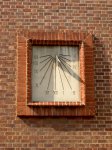 |
Alexandria |
Virginia |
USA |
Vertical Dial |
Dial 253 |
| A carved vertical dial approximately 46x41 inch, probably of sandstone, placed about 13 feet above street level. Dial face declines 22° W. |
| |
| |
 |
Alexandria |
Virginia |
USA |
Horizontal Dial |
Dial 254 |
| A bronze horizontal dial on a hexagonal pedestal. Gnomon angle measures 31.9°, wrong for local latitude. Gnomon is aligned southwest rather than true north. Dial sits in a former fountain installed in 1896. |
| |
| |
 |
Berryville |
Virginia |
USA |
Horizontal Dial |
Dial 520 |
| This lovely horizontal dial was originally located in New York City NY on the grounds of the Doubleday & Co. book manufacturing plant. It was subsequently moved to Berryville VA in 1956, and is now part of Berryville Graphics. The sundial stands about 4 feet high and has a brass reproduction of the Gutenberg Bible of Forty Two Lines (originally produced around 1455) and the hour markers are brass plates of twelve printers' marks from the earliest printers. |
| |
| |
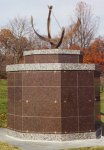 |
Fairfax |
Virginia |
USA |
Equatorial Dial |
Dial 432 |
| This bronze equatorial dial is about four feet in diameter with a 6 inch equatorial band containing raised Roman hour numbers from 5am to 7pm. The band is graduated every ten minutes and is offset by approximately 8 minutes to read Eastern Apparent Time. The gnomon is a simple arrow without nodus and the dial does not have an analemma. The octagonal dial base is made of brown marble panels approximately 5 feet high with a smaller octagon on top approximately 1 foot high that supports the dial. Each octagon is capped with thick granite. The base is a mausoleum, with alternate octagonal sides each containing 8 crypts. |
| |
| |
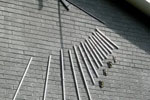 |
Falls Church |
Virginia |
USA |
Vertical Dial |
Dial 787 |
| A large vertical dial on the southwest brick wall of a private home. The hour lines are square PVC stock. Arabic hour numerals for noon to 7 PM are brass plated figures mounted on brass plaques. The dial declines 54 degrees from south to west. The ends of the hour lines indicate the solstices except for several long summer hour lines. The equinoctial points are marked by red glass inserts on the hour lines. |
| |
| |
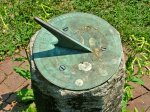 |
Fredericksburg |
Virginia |
USA |
Horizontal Dial |
Dial 193 |
| A 7 inch diameter brass horizontal dial with 3.5 inch high brass gnomon on a weathered octagonal stone pedestal. Reported to be contemporary with Mary Ball Washington's occupancy of this house in the 1780s. Dial sits atop a stone pillar. |
| |
| |
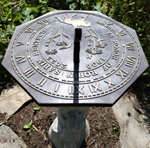 |
Great Falls |
Virginia |
USA |
Horizontal Dial |
Dial 1114 |
| This octagonal horizontal sundial measures 15 inches (380mm). It is made of bronze and given a brown patina with burnished letters, numbers and artwork. The dial has a chapter ring with Roman hours from V to VII delineated on the inner ring by half hours and the outer ring by quarter hours. It has a gnomon gap to accommodate the shadow of a 1/2 inch (12mm) wide gnomon. Artwork on both the dial face and gnomon was specifically drawn by Barbara Smith to honor Robin Sabin Rentsch with an equestrian motif and flowers grown at the Great Falls Library and tended by the Great Falls Garden Club. The dial sits on a pedestal in the form of a tree trunk with two squirrels racing upwards. The dial was 3D printed in plastic sections, assembled, and sent to Chicago Crucible, LLC where it was cast into bronze by Lloyd Mandelbaum. |
| |
| |
 |
Great Falls |
Virginia |
USA |
Analemmatic Dial |
Dial 1012 |
| This 12-foot E-W analemmatic sundial was the Eagle Scout project of Kenny Dieffenderfer who marshaled volunteers from Troop 1547 and parents. The dial has hour marks of bright yellow radiant suns from 5am to 7pm local time. The zodiac walkway is 30 inches wide, painted with a white background and line marks for each month and appropriate colorful drawings. The equinox is clearly marked and surrounding the dial are the cardinal markers of N, S, E, W. |
| |
| |
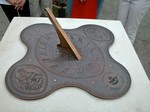 |
Great Falls |
Virginia |
USA |
Horizontal Dial |
Dial 633 |
| A phosphor bronze horizontal dial whose face is 17.7 inches across four rounded cruciform arms. Designed, made and presented by Tony Moss to commemorate the establishment of the first English settlement at Jamestown on May 14, 1607. The most striking feature is the inclusion of reproductions of the King James Great Seal of the English Virginia Company. The "navette" (little boat) shape of the seal is also reflected in a similar shape for the dial itself. These "English" features are balanced by an American input in the form of the "Celebrate Virginia" logo and that of the local Analemma Society that co-funded the pedestal along with Fairfax County Park Authority. A unique rounded-cruciform shape encompasses all the above elements together with the NASS logo and appropriate inscriptions. The dial is calibrated in 3-minute intervals and quarter hours. Square classical pedestal in reconstituted limestone made by Haddonstone UK. Pedestal is placed in a paved and railed area around the dial. A remarkable steel "safe" is provided to protect the dial and pedestal from theft or damage. |
| |
| |
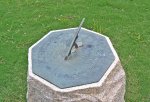 |
Jamestown |
Virginia |
USA |
Horizontal Dial |
Dial 724 |
| A 15 inch octagonal bronze horizontal dial with a bronze gnomon. Dial face shows hour, half-hour, quarter-hour and 5-inute marks with Roman hour numerals. The gnomon is damaged and analysis shows the dial hour lines are laid out for approximately 45° latitude instead of the local 37° latitude. The dial is on a white granite pillar. |
| |
| |
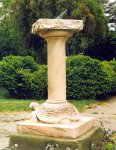 |
Leesburg |
Virginia |
USA |
Horizontal Dial |
Dial 255 |
| A small bronze horizontal dial 9.25 inches (23.5 cm) in diameter on an 18 x 18 inch (46 x 46 cm) block of marble. The pedestal of Tennessee marble rests on the back of a carved tortoise. The sides of the square block capital are deeply carved with oak leaves and acorns. When the dial was seen in 1998, the dial was not aligned to north. |
| |
| |
 |
Louisa |
Virginia |
USA |
Cylindrical Dial |
Dial 594 |
| An internal cylindrical dial built in a 16 foot diameter, 48 foot tall farm silo now located on a public golf course. The rim of the open top of the silo provides an elliptical shadow line on the inner wall of the silo. This is marked out with red hour lines and black date lines using the low point of the shadow on the wall as the time marker. The artwork has "three panels representing the continuity of man's perceptions of space: past, present, and future. In an abstract sense, the sundial represents the scientific, emotional, and philosophical struggles and triumphs of mankind." Contact Tanyard Country Club Golf Pro Shop at 540-967-1889 to ensure the silo door is open. |
| |
| |
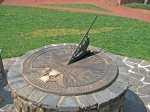 |
Lynchburg |
Virginia |
USA |
Horizontal Dial |
Dial 627 |
| A 48 inch diameter bronze horizontal dial on a stone pedestal. Polar gnomon includes a scroll and stylized peacock. Dial furniture includes an hour glass and eagle wings. The perimeter around the dial is inscribed, "TIME LIKE LIFE CANNOT BE RECALLED." The dial sits atop a cylindrical mortared stone pedestal. |
| |
| |
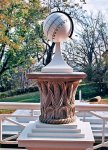 |
Monticello |
Virginia |
USA |
Globe or Hemispheric |
Dial 470 |
| A replica of Jefferson's lost dial, which he recounted in 1817, "My dial captivates every body foreign as well as home-bred, as a handsome object & accurate measurer of time." Made according to Jefferson's design, the replica dial is a 10 1/2 inch painted wood sphere with horizontal lines drawn for the equator, Tropics of Cancer and Capricorn. Longitudinal lines are drawn between the two tropics to indicate the hours of the day. A gnomon fixed to the poles swings around the globe until it casts the smallest meridian shadow. The original sphere was made of black locust wood but the replica is mahogany because it is "more durable, stable and easier to find." The base was originally a model of a capital, the top part of a column, that Latrobe had designed for the U.S. Capitol. It was unique, featuring ears of corn in motif. When Jefferson received the base from Latrove, "it looked bald for want of something to crown it" and so Jefferson designed a globe that "might be made to perform the functions of a dial." |
| |
| |
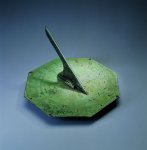 |
Mt. Vernon |
Virginia |
USA |
Horizontal Dial |
Dial 167 |
| A bronze octagonal horizontal dial about 12 inches on a side. Original dial is badly worn and virtually illegible; this original is now stored inside the museum. A 6 inch replica of the dial is located on a pedestal in the center of a circular lawn. This replica has an 8-pointed compass rose in the center and Roman numerals from 5 AM to 7 PM. The hour intervals are graduated into two-minute increments, with Arabic numerals 20-40-60 at appropriate places between the hour lines. Pictures of both the replica and the original dial are in the Image Archive. |
| |
| |
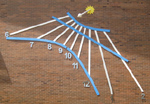 |
Newport News |
Virginia |
USA |
Vertical Dial |
Dial 862 |
| This vertical dial declines 28 degrees east, and was commissioned as educational artwork for the new Discover STEM Academy (Magruder Elementary School). The dial is 21 feet wide and 14 feet tall consisting of quarter inch by 3 inch aluminum planks for the hour lines and 4 inch aluminum pieces for the solstices and equinox lines. The hour lines are adjusted for longitude, with stainless steel Arabic numerals showing the time from 6am to 2pm at the bottom of each hour line. The gnomon is a 2 inch rod 40 inches long with a 6-inch nodus ball set back slightly from the rod end. The gnomon is held to the wall by an 18 inch yellow sun. |
| |
| |
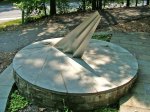 |
Reston |
Virginia |
USA |
Horizontal Dial |
Dial 369 |
| A modernistic seven foot diameter flagstone horizontal dial with hour lines. The design features a gnomon of folded stainless steel plate. Gnomon is truncated too short for shadow to reach edge of dial face. See "Sightings" in NASS Compendium Vol. 6 No. 4, Dec 1999. |
| |
| |
 |
Reston |
Virginia |
USA |
Analemmatic Dial |
Dial 773 |
| An analemmatic dial with 8 foot semimajor axis painted on the asphalt playground of the Neil Armstrong Elementary School. Hour marks for 5 AM to 7 PM include longitude correction; Arabic hour numerals for both standard and daylight saving time are shown. The date line is decorated in bright colors with icons symbolic of holidays and seasonal weather.
The dial was the Boy Scout Eagle Service Project of William T. Spriggs and was painted by local Boy Scouts and their fathers. |
| |
| |
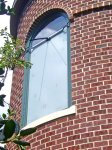 |
Richmond |
Virginia |
USA |
Vertical Dial |
Dial 635 |
| An 87 x 37 inch vertical stained glass sundial in a second story window on the south wall of a tower at Richmond Hill, a historic monastery in Richmond. The glass area of the dial is frosted with hour lines and numerals read from the inside. Richmond Hill is open to the public Tuesday through Sunday; visitors are welcome to view the sundial, which is located in a tower accessible from the main lobby entrance. |
| |
| |
|
Richmond |
Virginia |
USA |
Obelisk or Vertical Gnomon |
Dial 173 |
| 'Built in 1981 after an article in Scientific American (Dec 1980 "The Amateur Scientist") described a computer program for building a gnomonic dial with analemma hour lines. The dial was painted on the museum's parking lot, using a ball atop a 25 ft aluminum flagpole as the nodus. Semi-annual analemmas were painted in different colors, allowing correction for the equation of time. The dial was refurbished June 1992. |
| |
| |
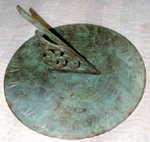 |
Richmond |
Virginia |
USA |
Horizontal Dial |
Dial 977 |
| A bronze dial 11.5 inches in diameter, 21 inches high. It is signed by Thomas Hart and dated 1765. The inscription on the dial implies a much later date of late 1800's or early 1900's. |
| |
| |
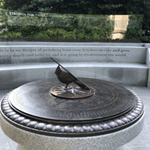 |
Richmond |
Virginia |
USA |
Horizontal Dial |
Dial 994 |
| A large circular plaza holds 7 life sized bronze statues of influential Virginia women during the last 400 years. The plaza will eventually feature 5 more life-size bronze statues. Dedicated in Oct 2019 this monument is a work in progress with other women still to be recognized. In the center of the plaza on a wide circular granite pedestal is a bronze horizontal sundial. In addition to the normal dial furniture of compass rose, inscriptions, site latitude & longitude, and a chapter ring with the hours from 5am to 7pm there is additional information: points of interest in Virginia shown around the dial in the outer chapter ring. Each location is listed by name, azimuth, and distance from the Capitol site. Underneath the style of the gnomon is a bronze Northern Cardinal, the state bird of Virginia. |
| |
| |
 |
Stafford |
Virginia |
USA |
Vertical Dial |
Dial 978 |
| This vertical dial is 12 feet tall and nearly 20 feet wide. It is made of quarter-inch aluminum. The white hour lines running from 10am to 5pm are 4-inches wide. They run from the summer to winter solstice. The blue solstices and equinox line are quarter-inch aluminum 5-inches wide. The gnomon base is a yellow sun 10-inches in diameter with a 2-inch diameter gnomon. The nodus on the gnomon is a sphere 6-inches in diameter. |
| |
| |
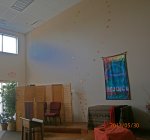 |
Sterling |
Virginia |
USA |
Gnomonic or Projection Dial |
Dial 778 |
| A reflection dial using a mirror in an upper window to project a solar image spot onto the west facing vertical interior wall of a church. Copper medallions on the wall show the spot location at 10:30 AM throughout a year and depict the analemma curve. |
| |
| |
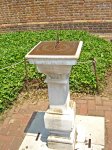 |
Williamsburg |
Virginia |
USA |
Horizontal Dial |
Dial 115 |
| A 14 inch square brass horizontal dial with hour lines and Roman numerals, compass rose and inscriptions honoring John Barrow. A fluted square pillar supports the dial. |
| |
| |
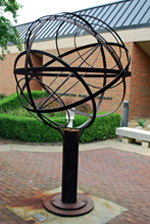 |
Williamsburg |
Virginia |
USA |
Armillary Sphere |
Dial 877 |
| This armillary is constructed of welded carbon steel narrow bands approximately 4-feet in diameter sitting on an iron post about 3-feet high. The equatorial band has no engraved or embossed time marks, but the simple rod gnomon has two side rods. According the the WPL website, "Time on the sundial is read by looking at where the gnomon shadow is cast. This shadow will be the middle, thicker shadow of the three shadow-lines ... Although hours are not marked off on this sundial, you can estimate the time of day by thinking of the gnomon shadow hoop as the clock face and the shadow as the hour hand of that clock." Well, not exactly. The hours are at 15-deg intervals with 12 noon at the bottom of the equatorial band at the intersection of the meridian band. This armillary is more of a sculpture than a timepiece. Yet the armillary has the traditional tropic of Capricorn and Cancer bands as well as Arctic, Antarctic,and horizontal bands. |
| |
| |
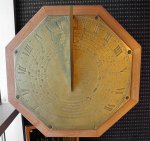 |
Williamsburg |
Virginia |
USA |
Horizontal Dial |
Dial 116 |
| A unique bronze 12-3/8 inch octagonal horizontal dial with one main hour ring for local time and six subsidiary rings that give the time in London, Vienna, Constantinople, Jerusalem, Barbados and Mexico City. The main hour ring shows hours in Roman numerals and ten minute intervals in Arabic numbers; each hour is divided into sixty minute intervals and "fleur-de-lis" decorations are placed at the thirty-minute marks. The subsidiary rings are inscribed with Roman numerals for daylight hours and Arabic numbers for night hours. The presence of subsidiary rings suggests the dial was made with an instructive or "world-view" intent. |
| |
| |
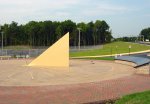 |
Woodbridge |
Virginia |
USA |
Horizontal Dial |
Dial 534 |
| A large 62 foot diameter horizontal sundial of grey concrete and brick with a 10 foot high steel gnomon. The dial was designed to memorialize the victims of the 9/11/2001 terrorism and includes four inlaid plaques on which the gnomon shadow falls at 8:45, 9:03, 9:37 and 10:07 AM, the times of the four air crashes. Hour markers are inset brass Roman numerals. The hour lines and NESW compass rose are 2 inch wide inset brass strips. |
| |
| |
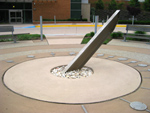 |
Woodbridge |
Virginia |
USA |
Horizontal Dial |
Dial 861 |
| This horizontal dial sits on a low concrete dais 13 feet in diameter. At the interior is an oculus 3 feet in diameter with loose gravel from which a 10-inch I-beam gnomon emerges. The I-Beam extends approximately 4 feet into the air with the north end cut vertical to the ground and then canted back creating a graceful taper on the underside. The dais concrete is of two colors: an inner pink ring 9 feet in diameter and an outer earth-toned ring that serves as a 2 foot wide chapter ring. |
| |